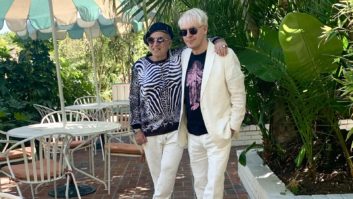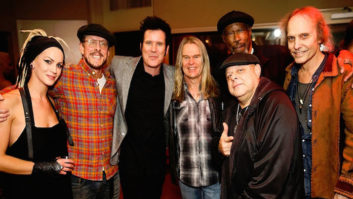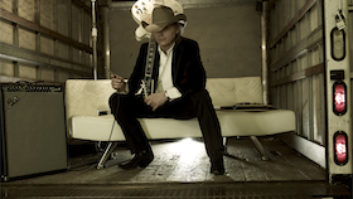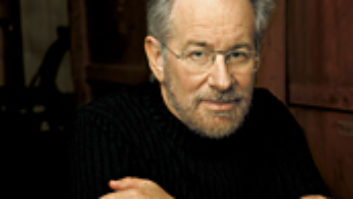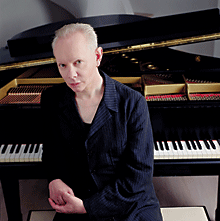
Joe Jackson doesn’t waste time with nostalgia. Look Sharp may have been your favorite album in 1979, but when Jackson reunited his original band a few years ago, it wasn’t to indulge in a money-grabbing reunion tour or to relive anyone’s new wave childhood. He simply had some new songs written and, for the first time since Beat Crazy in 1980, thought that his original bandmates were the best musicians for the job.
So in 2003, Jackson went back into the studio with guitarist Gary Sanford, bass player Graham Maby and drummer Dave Houghton, and made a rocking album called Volume 4 — so named because it was his fourth studio production with the group. Three years later, Jackson’s musical mood was just a bit different. He called back only Maby and Houghton, and recorded/self-produced a stunning piano-trio collection called Rain.
Jackson is a talent of truly broad-reaching abilities and interests. His piano work and his singing are always brilliantly effective. Rock ‘n’ roll, jump blues, jazz, classical — the style of his music is simply a matter of his own choosing. Rain happens to be a jazz- and classical-influenced singer/songwriter album with a few rocking tracks — easily imaginable for fans who have followed Jackson over the years.
“Joe always has a clear idea of how he wants his music to sound,” says recording engineer Julie Gardner, who recorded Jackson’s Volume 4 and live album Afterlife, as well as Rain. “He took the band on tour to warm up before they made the album to make sure they were really tight. But they’re amazing musicians anyway, so they were completely tight with each other and knew the songs really well before they came into the studio.”
Jackson, who has homes in New York City, London and Berlin, had chosen Planet Roc Studios to record Rain. Before the wall came down, Planet Roc was an East Berlin radio station that must have broadcast live musical performances — the rooms are big and, Gardner says, “acoustically very beautiful. Sony Publishing in Berlin took Joe around to various studios, and he liked this one because he wanted a great-sounding room where we could record a grand piano and it would be big enough to have the band set up in the same room.
“They had a big range of vintage microphones and mic preamps, which was brilliant,” continues Gardner, whose career included years engineering at top London studios The Townhouse and Olympic. She now runs jamDVD, which specializes in live recordings and DVD production. “There were some problems with the control room — the tape machine and patchbay were a little run down — but we got around these problems and made a brilliant album.”
Gardner’s observations about Planet Roc’s control room are particularly meaningful, as Jackson records to analog — in this case, an Otari MTR90 2-inch machine. “This is a different discipline to get back to as almost all my work is now done on Pro Tools. With Pro Tools, you have more options: everything is nondestructible, fixable or you can simply undo. With tape, you really have to be precise and know exactly what you are going to do before you punch in, which can be difficult when dropping in on drums and grand piano. Joe is one of the few artists who still likes using tape, which, without doubt, does sound great.”
The tracking setup at Planet Roc began with Jackson and his grand piano. Bassist Maby stood to his left, and drummer Houghton and his kit were situated next to a wall, in front of Jackson. Gardner captured the rhythm tracks first, with Jackson playing along on an electric keyboard and singing a guide vocal. Later, she would record the final piano and lead vocal tracks, and backing vocals. She says she experimented with Jackson’s vocal mic on Volume 4 and again on Rain, and both times decided a Neumann U87 was best for his voice.

“For the piano sound, I used a AKG solid tube large-diaphram mic down the bottom of the piano,” she recalls. She also placed two Schoeps CMC 5s with MK2G capsules at the front, above the hammers, and one Schoeps SMC 5 above the highest strings.

A break in Berlin (L-R): Graham Maby, Dave Houghton and Joe Jackson
Gardner was also creative with capturing natural reverb: “The studio in its heyday was used for Foley,” she explains, “so besides there being different surfaces on floors and different types of acoustics and props in rooms, behind where we had the grand piano in the main room was a large staircase. Underneath the stairs was a cellar, so I left the door open and put a microphone in there, which I faced toward the wall. The room sounded like a chamber, which I recorded and used as an effect. I also used a Neumann SM69 stereo microphone, positioned high in front of the drums in the main room to capture the room sound of the drums.”
Gardner also makes a point of mentioning that her experience recording these wonderful musicians in a gorgeous old studio was all the better because the facility provided an excellent assistant engineer, Yensin Jahn. “He was really brilliant and knew the studio really well. He and Christian Bader, who owns Planet Roc, did their best to make sure everything ran as smoothly as possible, that we were all comfortable and well looked after. Christian was also responsible for getting me the large range of different vintage Neumann microphones, which we tried out on Joe’s vocal before settling on the U87.”
Before leaving Berlin, Gardner and Jackson put together rough mixes of the tracks for him to take to New York City, where the album would be team-mixed by engineers Paul Kolderie and Sean Slade, who also mixed Volume 4.
“Julie’s tracks are beautifully organized and very musical,” Slade says. “It’s a pleasure working on them. We’ve worked on two albums together, but we’ve never met,” Slade says.
Slade and Kolderie have known each other since they were in bands together in college. They’ve been working as a production team since the late ’80s, when they opened Fort Apache Studios in Cambridge, Mass. Together, they worked at their craft and their business, and in time began attracting major-label clients, such as Hole, Warren Zevon, Mighty Mighty Bosstones and Radiohead.
Jackson’s manager had heard their mixes of the first two Radiohead albums and liked the idea of pairing them with Jackson. Kolderie and Slade mixed Volume 4 in Steve Rosenthal’s studio, The Magic Shop (New York City), and Jackson was happy to return there for Rain.
“We like The Magic Shop. It’s a nice, funky studio, it’s got a great sound, a great custom Neve board — we love that board, and we’ve mixed million-selling albums on it,” Kolderie says.
Another key benefit of working on Jackson’s projects at The Magic Shop is Rosenthal’s supply of well-maintained analog gear. Kolderie and Slade played the recordings back on a Studer machine and mixed to an Ampex half-inch ATR 102. They also took full advantage of the studio’s vintage outboard pieces.
“We dug around in the basement of The Magic Shop, and we came up with an old Aphex professional sound enhancer, a broadcast unit — you have to adjust it with a screwdriver,” Kolderie recalls. “I remembered they used to use that for Warren Zevon to get that L.A. piano sound back in the ’70s. We slapped it on the piano, and it really made it stand out and sparkle, and gave it that sound that Joe was looking for.
“They also have a fantastic old Gates SA39B tube limiter — I have one at my own studio, too — and I swear by it,” Kolderie recalls. “It’s from the ’60s. I got mine from a guy I know that bought old radio stations and sold them off in chunks. It’s the kind of thing that in an old radio station would be the last piece in the chain; it was meant to drive the long transmission line to the tower.”
Kolderie says he also used the studio’s Alan Smart C2 limiter across the stereo bus, a TC Electronic Finalizer and a couple of UREI LA2 limiters, but he points out that most of the work happened inside the console: “Other people have outboard modules of consoles like that, but The Magic Shop has the whole console, so you don’t need a lot of outboard there. You don’t need to patch in something else to make it sound good.”

Recording engineer Julie Gardner says the rooms at Planet Roc are “acoustically very beautiful.”
Slade says they mixed about a song a day on average, but one of the unique qualities of this project was that the tracks were never regarded as totally separate pieces. “He came in with a sequence already established,” Slade explains. “He constructed it as sort of a song suite. A term like that might come off as being pretentious, but it did have a real order to it and a flow.”
Slade and Kolderie actually mixed the tracks in album order. “It would be like a filmmaker shooting in the order the scenes occur, so you get a cumulative effect where you’re able to see the bigger picture and you’re able to concentrate on the details in a more natural, intuitive kind of way,” Slade says.
During the mix, Kolderie naturally takes on more of the technical work while Slade is more focused on arrangements, but they’re definitely both hands-on. “When we work with bands, they always think it’s really unusual because when we mix, Paul takes half the board and I take the other half of the board,” Slade says. “He’ll mix more of the drums and bass — he’s a bass player — I’ll do the piano, background vocals, other percussion.
“When we started, I thought it was the most natural thing in the world, but Paul and I came from a do-it-yourself background,” he continues. “Neither of us went to recording school or anything. We had never worked in studios, but we started our own, and neither of us knew the ‘correct’ way to go about things. So when people see us, they’ll say, ‘Boy, that’s really weird, you don’t even talk to each other when you’re mixing.’ I’ll lean over and jiggle one of his EQs, and he’ll lean over and jiggle one of my EQs, and that’s fine. It’s just the way it works.”
Apparently, Slade and Kolderie’s methods work beautifully, as Jackson’s new album is outstanding; his artful songs are realized with sparkling piano playing, passionate vocals and masterful accompaniment.
“The main thing is he sings beautifully,” Slade says. “It was just getting the music into a space where you didn’t need to work at all to hear how well-written the lyrics were — getting the emotion right there so you don’t have to do anything but enjoy it and understand the story the music is telling.”
PLAY: Must Play
Rush Across the Road
